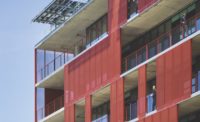With cities worldwide facing daunting environmental challenges on a global scale, a multidisciplinary team at Arup seeks to create a model for how cities can develop carbon neutrally
Once upon a time, when the world’s population was a fraction of the 6.5 billion it is today, environmental issues were thought of as local problems. Writers, politicians, scientists, and activists have recorded the polluted, disease-producing conditions of urban centers for centuries. Benjamin Franklin petitioned the Pennsylvania Assembly in 1739 to stop dumping waste and remove tanneries from Philadelphia’s commercial district, citing foul odors, lower property values, and disease. And yet, even the proto-environmentalist Franklin could not predict that centuries of local industrial recklessness would one day endanger the entire planet.


In 2007, environmental issues are literally global in that the carbon emissions of every industrialized country have accumulated to create the present damaging climate changes. From Al Gore’s 2006 documentary An Inconvenient Truth to the release last month of “Climate Change 2007,” a six-year study about global warming from the Intergovernmental Panel on Climate Change, there seems to be little doubt that the by-products of industrialization—greenhouse gases, particularly carbon dioxide (CO2)—are responsible.
Even before the latest reports, a new model for confronting global warming has gained traction. The new model, variously referred to as zero-carbon, carbon-neutral, or fossil-free development, is a revolutionary attempt to stop and, where possible, reverse the damage. Whereas there are currently no such zero-carbon cities in the industrialized world, an experiment is unfolding that attempts to create a carbon-neutral city from scratch and provide a prototype for the future of all cities in one of the world’s most environmentally distressed countries, China.
China syndrome
Adjacent to booming Shanghai, plans are coming together for the prototypical city of Dongtan, which designers argue would be the world’s first truly sustainable new urban development. London-based Arup and the Shanghai Industrial Investment Corporation (SIIC), the city’s investment branch, have partnered to create a master plan for Dongtan, an area three quarters the size of Manhattan. The brief calls for integrated sustainable urban planning and design to create a city as close to carbon-neutral as possible within economic constraints. Located in sensitive wetlands on Chongming Island at the mouth of the Yangtze River just north of Shanghai, Dongtan’s first phase, a marina village of 20,000 inhabitants, will be unveiled at the 2010 World Expo in Shanghai. By 2020, nearly 80,000 people are expected to inhabit the city’s environmentally sustainable neighborhoods.
As a strategic partner, Arup is responsible for a range of services, including urban design, sustainable energy management, waste management, renewable energy process implementation, architecture, infrastructure, and even the planning of communities and social structures. Peter Head, director of Arup’s sustainable urban design, leads the project for the firm from its London’s office (during design, Arup is offsetting the emissions of its team’s travel to and from the site in cooperation with emissions brokerage firm CO2e). “Renewable energy will be used to reduce particulate CO2 emissions. Transport vehicles will run on batteries or hydrogen-fuel cells and not use any diesel or petrol, creating a relatively quiet city,” he explains. Other priorities include recycling organic waste to reduce landfills and generate clean energy.
Head insists development won’t affect the wetlands. “First of all, water usually discharged into the river will be collected, treated, and recycled within the city boundaries,” he says. “There will be a 2-mile buffer zone of eco-farm between city development and the wetlands.” While farming is water intensive, relatively small amounts of water reach the plants themselves. Head says Dongtan “will capture and recycle water in the city and use recycled water to grow green vegetables hydroponically. This makes the whole water cycle much more efficient.”
There are, of course, questions about what kind of sustainable industries will provide jobs for Dongtan residents. City officials and their consultants anticipate jobs in education, including an Institute for Sustainable Cities. They expect to attract companies pursuing new technologies, food research and production, and health care. Of course, ecotourism will become a significant industry. The plans for the development have already garnered their fair share of press in the design world [RECORD, March 2006, page 46].




Post a comment to this article
Report Abusive Comment